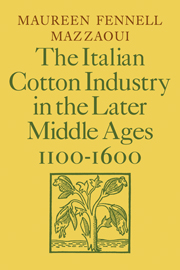Book contents
- Frontmatter
- Contents
- List of illustrations
- Preface
- List of abbreviations
- Map
- Introduction
- PART ONE THE ROLE OF COTTON IN THE MEDITERRANEAN ECONOMY
- 1 Cotton cultivation in the ancient and medieval world
- 2 The Mediterranean cotton trade 1100–1600
- PART TWO THE ORGANIZATION OF THE NORTH-ITALIAN INDUSTRY
- PART THREE THE GROWTH OF COTTON MANUFACTURE NORTH OF THE ALPS
- APPENDICES
- Notes
- Select bibliography
- Index
2 - The Mediterranean cotton trade 1100–1600
Published online by Cambridge University Press: 05 March 2012
- Frontmatter
- Contents
- List of illustrations
- Preface
- List of abbreviations
- Map
- Introduction
- PART ONE THE ROLE OF COTTON IN THE MEDITERRANEAN ECONOMY
- 1 Cotton cultivation in the ancient and medieval world
- 2 The Mediterranean cotton trade 1100–1600
- PART TWO THE ORGANIZATION OF THE NORTH-ITALIAN INDUSTRY
- PART THREE THE GROWTH OF COTTON MANUFACTURE NORTH OF THE ALPS
- APPENDICES
- Notes
- Select bibliography
- Index
Summary
The emphasis given to the spice trade in Western commercial development has tended to overshadow the larger and far more important role of raw materials and foodstuffs which in volume far outweighed spices in Mediterranean cargos. The expansion of the Western economy was directly linked to the emergence of innovative entrepreneurial structures in the large-scale textile industries which were dependent upon the maintenance of a consistently high level of imported raw materials. Beginning in the eleventh century, the conquest of Eastern territories and the founding of commercial stations overseas gave European merchants a foothold in the major production zones of raw materials, which included textile fibers (wool, cotton, silk), dyes, alum and potash. While the importation of oriental luxuries continued and even increased, commercial activity from the twelfth century on was oriented more and more toward the acquisition of industrial raw materials and the opening of foreign outlets for finished goods.
Silk and dyestuffs which commanded a high price per unit of weight, were officially classed as ‘spices’ and formed part of the valuable cargos of the Italian galleys in the late Middle Ages. By contrast, the bulky commodities of wool, cotton, alum and potash were carried on slower ships of both large and small tonnage in a complex and highly diffuse pattern of traffic. The transport of mundane industrial commodities was at the heart of a complex system of commercial financing and capital investment which attracted the wealth and attention of the greatest merchants of the period.
- Type
- Chapter
- Information
- Publisher: Cambridge University PressPrint publication year: 1981



